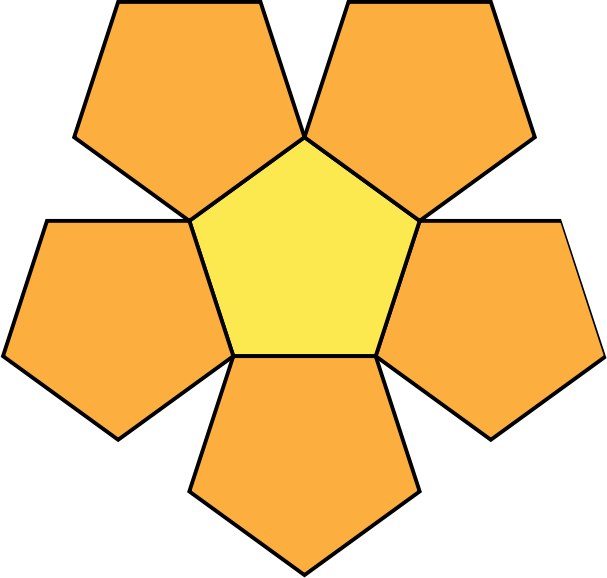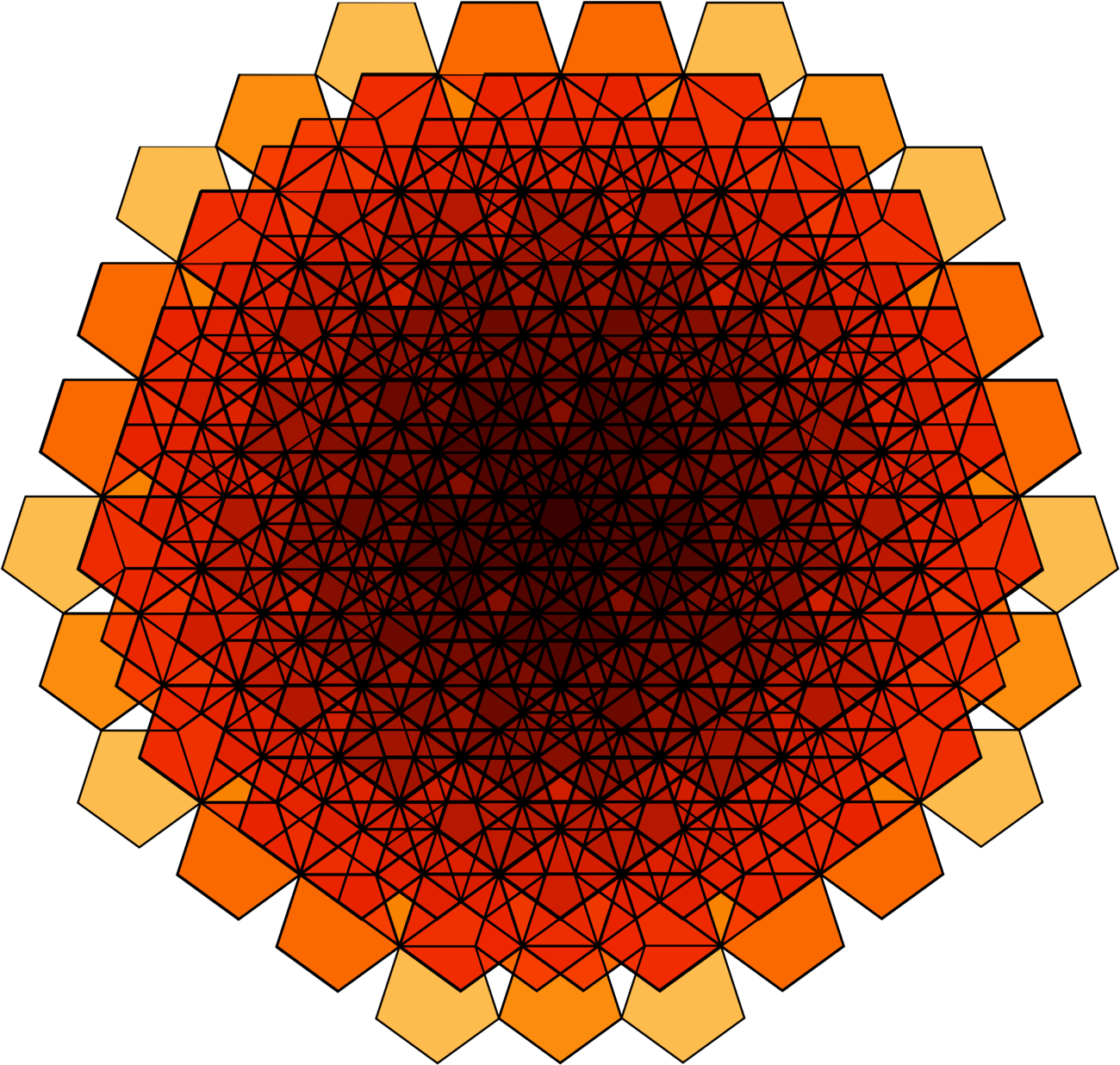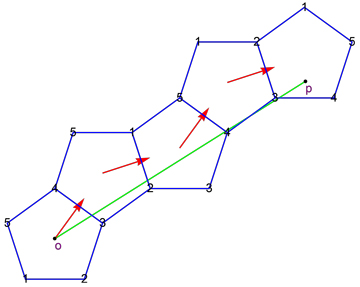Here are a few trivial lemmas. I won't use anything about the rolling motion, just that the distance is defined by gluing pentagons edge-to-edge:
- The $dd$-circle of radius $k$, which I'll call $C_k$, is a closed polygonal curve. Let $D_k$ be the closed $dd$-disk of radius $k$; note that $D_k$ may contain holes and $C_k$ is not in general simple! (This happens even at $k=2$.)
- The orientations of the line segments forming $C_k$ (measured relative to the $+x$ ray) when $k$ is even (odd) take the form $\pi m/5$ with $m$ an odd (even) integer; this is because pentagons are glued to each other in only two orientations (up-pointing or down-pointing) and furthermore, we can only glue down-pointing pentagons to up-pointing ones and vice versa. (Note also that no line segments of $C_k$ lie on $C_{k+1}$).
- It's not hard to see that $C_k$ is strictly contained within $D^\circ_{k+2}$, the interior of $D_{k+2}$ (the open $dd$-disk). Suppose that $v$ is a simple vertex of $C_k$ so that the interior angle $\alpha$ is defined and $\alpha> 4\pi/5$. Then $v$ is surrounded by the pentagons added to its adjacent segments and therefore lies inside $D^\circ_{k+1}$. Otherwise, if the interior angle $\alpha\leq 4\pi/5$ then $v$ is also a vertex on $C_{k+1}$. However the interior angle at $v$ on $C_{k+1}$ is now $\alpha+6\pi/5>4\pi/5$, so it gets "eaten up" in the next layer.
Here are pictures of $D_k$ for $k=1,\dots,8$ placed side by side with $D_{k}\setminus D_{k-1}$, (made by "hand" from edited versions of this file from wikipedia):
$D_1$:

$D_2$ and $D_2\setminus D_1$:


$D_3$ and $D_3\setminus D_2$:


$D_4$ and $D_4\setminus D_3$:


$D_5$ and $D_5\setminus D_4$:


$D_6$ and $D_6\setminus D_5$:


$D_7$ and $D_7\setminus D_6$:


$D_8$ and $D_8\setminus D_7$:


From these images, the following patterns are apparent: the "outer frontier" of $C_k$ is determined by a closed chain of $5k$ pentagons joined vertex to vertex. When $k$ is odd, these pentagons are all "down-pointing" and when $k$ is even they all are "up-pointing". From now on assume $k\geq2$. Then the pentagon chain is formed from 10 "segments of pentagons", which I'll call pentasegments, joining 10 corner pentagons where the pentasegments change direction.
There are two types of pentasegments: those where the bases of the constituent pentagons point outwards relative to the interior of $D_k$ (type I):

and those where the vertices of the pentagons point outwards (type II):

The top pentasegment of $C_k$ is type I if $k$ is odd and type II if $k$ is even and the 10 pentasegments alternate between type I and type II so that there are 5 of each type.
When $k$ is even, there are $k/2-1$ pentagons on each pentasegment lying strictly between the corners (the number of pentagons on each pentasegment including the 2 corners is $k/2+1$).
When $k$ is odd, there are $(k-1)/2$ pentagons on each type I pentasegment between the corners and $(k-3)/2$ pentagons on each type II pentasegment between the corners. There are holes between each of the pentagons lying on the type II pentasegments, thus there are $5\lfloor \frac{k}{2}\rfloor$ holes in total.
I think the above gives a full characterization of $C_k$ and also shouldn't be too hard to prove, though I'm finding it awkward to turn the pictures into words. First, the corners propagate along "zig-zag" paths of pentagons; for example, a formula for the coordinates in $\mathbb{C}$ of the centroid of one of the corners of $C_k$ is:
$$2r_{in}\sum_{j=1}^ke^{i\pi m_j/5},$$
where $r_{in}=\frac{1}{2}\sqrt{1+\frac{2}{\sqrt{5}}}$ is the inradius of the regular pentagon (formula from mathworld), $m_{2l-1}=2$, and $m_{2l}=1$. This simplifies to:
$$\left\lceil\frac{k}{2}\right\rceil e^{2\pi i/5}+\left\lfloor\frac{k}{2}\right\rfloor e^{\pi i/5},$$
and there are 9 other similar formulas for the other corners. Another easy step is seeing that type I pentasegments turn into type II pentasegments (and vice versa) after attaching the next layer of pentagons, and seeing how the number of pentagons along each type of pentasegment changes is also straightforward. Maybe there's a more elegant description which might then lead to a simple formula / algorithm to compute $dd(p)$.
Here's some geometry which may help in writing an algorithm; as you can see, the details are straightforward but rather messy. If I haven't screwed up the law of cosines, the centroids of the corner pentagons of $C_k$ lie on the circle of radius $R_k$ centered at the origin, where:
$$\left(\frac{R_k}{r_{in}}\right)^2=\left\lceil\frac{k}{2}\right\rceil^2+\left\lfloor\frac{k}{2}\right\rfloor^2+2\left\lceil\frac{k}{2}\right\rceil\left\lfloor\frac{k}{2}\right\rfloor\cos\frac{\pi}{5}.$$
The 10-gon $P_k$ formed by these centroids is inscribed in this circle and is determined once we calculate the polar angles of two neighboring centroids, $\alpha_k,\beta_k$. This can be done with the law of sines but I won't write out expressions explicitly here.
Let $S_k$ be the polygonal annulus lying strictly between $P_k$ and $P_{k+1}$. Given a point $p$, it will lie in some $S_k$ or on some $P_k$, and this tells us that $|dd(p)-k|\leq 1$. I don't know what the best algorithm for determining this $k$ is (something using the polar coordinates of $p$?), but I suspect Joseph O'Rourke will know. Once we get $k$, then it's possible to pin down $dd(p)$ exactly by analyzing in more detail where $p$ sits relative to the edges of $C_k$, though again I'm not sure what the most efficient algorithm would be.






















